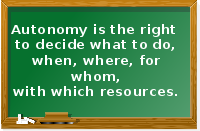Humans and autonomy: a topic that has a long history in debate, philosophical discussions, academic writing and literature. And, of course, stories and movies. User-centered innovation employs a pragmatic definition of ‘human autonomy’. This definition supports the analysis of humans: how they behave in solutions in which many different humans and machines participate. In user-centered innovation: “Autonomy is the right to decide what to do, when, where, for whom, with which resources.”
From the perspective of user-centered innovation it is recognised that humans that participate in one solution are also engaged in other solutions and tasks, jobs, activities, et cetera. The participation of a human in one solution may be to fulfill a bigger purpose, unknown to the participants in that other particular solution. Many factors influence how a human behaves within a solution: Although the solution may prescribe certain behaviour, a participant may have reasons to behave differently…
This pragmatic definition of autonomy is in accordance with studies that show that increased human autonomy has a positive effect on well-being and (job) performance. Basically, allowing more autonomy provides a human with more possible behaviours to handle ordinary, and out-of-the-ordinary situations. The reverse, namely restricting autonomy (or even: micromanaging) ensures that it becomes difficult to adapt to changes.
Studies also show that autonomy is not a panacee: the person needs to have the knowledge, experience, skills and opportunity to be able to act autonomously. Consider the example of driving a motorcycle from Delft to Paris in five hours: I only can fulfill this task autonomously if I can actually drive a motorcycle, have a license, know the route, have a motorcycle, et cetera. (Note: I cannot drive a motorcycle so I am not qualified to autonomously undertake this activity.)
For successful user-centered innovations it is key to guarantee the autonomy of the participants.
A non-exhaustive list of starting points to read more on human autonomy:
- Autonomy is related to ‘morality’ and ‘free will’. Quick starting points are the wikipedia pages on Immanuel Kant and René Descartes.
- Overview of the concept of Autonomy on Wikipedia.
- Dictionary definition of Autonomy on Wiktionary.
- Stories and movies: There are too many! Consider stories about a person, group, or country to gain independence, about being able to make their own decisions, about creating choices in their life.
- Interesting read on autonomy and human performance by Ozer, M. (2011). A Moderated Mediation Model of the Relationship Between Organizational Citizenship Behaviors and Job Performance. Journal of Applied Psychology, 96(6):1328-1336, http://dx.doi.org/10.1037/a0023644. Summarised by e.g. Bret Simmons (SoundCloud)
- Autonomy and well-being: interesting read by
-
- Fischer, R. & Boer, D. (2011). What is more important for national well-being: Money or autonomy? A meta-analysis of well-being, burnout and anxiety across 63 societies. Journal of Personality and Social Psychology, 101:164-184. DOI: 10.1037/a0023663. Summarised by e.g. Rick Nauert (PsychCentral) and available at ResearchGate.
- Autonomy depends on the person and the task: see for example more on Situational Leadership theory on Wikipedia.





